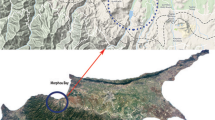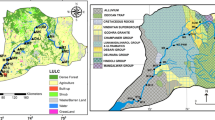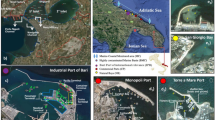Abstract
Fish consumption, especially consumption of oily marine species, is increasing globally due to its recommendation by dieticians. This is due to high polyunsaturated \(\omega \)-3 and \(\omega \)-6 (PUFAs) fatty acid content in the tissue of the fish. The health benefits of PUFA ingestion coincide with the risk of intaking hazardous lipophilic persistent pollutants including organochlorine pesticides (OCPs) and related polychlorinated biphenyls (PCBs). We examined the impact of 17 fatty acids (FAs) and 36 toxic organic and inorganic contaminants on the behavior patterns of the indicator congener PCB-138 in marine fish using eXtreme Gradient Boosting (XGBoost), SHapley Additive exPlanations (SHAP), and SHAP value fuzzy clustering. XGBoost indicated non-linear relationships between PCB-138 and other investigated variables that were explained by SHAP values. The ten obtained fuzzy clusters of SHAP values revealed that a higher intake of saturated myristic-C14:0 and margaric-C17:0 acids followed by the intake of nutritionally beneficial eicosadienoic acid (C20:2n-6) mostly do not increase the bioaccumulation of PCB-138. Important effects on PCB-138 behavior patterns were also recorded for the chemically allied indicator congeners (\(-153\), \(-180\), \(-118\) and\( -101\)) and organochlorines’ metabolite p,p’-DDE. Associations between the target congener and the toxicologically relevant PCBs (\(-123\) and \(-170\)) were less prominent.
Access this chapter
Tax calculation will be finalised at checkout
Purchases are for personal use only
Similar content being viewed by others
References
Brucka-Jastrzêbska, E., Kawczuga, D., Rajkowska, M., Protasowick, M.: Levels of microelements (Cu, Zn, Fe) and macroelements (Mg, Ca) in freshwater fish. J. Elementol. 14, 437–447 (2009)
Chen, T., Guestrin, C.: Xgboost: A scalable tree boosting system. In: Proceedings of the 22nd Acm sigkdd International Conference on Knowledge Discovery and Data Mining, pp. 85–794 (2016)
Cook, C.M., Hallaråker, H., Sæbø, P.C., et al.: Bioavailability of long chain omega-3 polyunsaturated fatty acids from phospholipid-rich herring roe oil in men and women with mildly elevated triacylglycerols. Prostaglandins Leukot Essent Fatty Acids 111, 17–24 (2016)
Davidson, M.H.: Omega-3 fatty acids: new insights into the pharmacology and biology of docosahexaenoic acid, docosapentaenoic acid, and eicosapentaenoic acid. Curr. Opin. Lipidol. 24, 467–474 (2013)
Đinović-Stojanović, J., Nikolić, D., Vranić, D., Babić, J., Milijašević, M., Pezo, L., Janković, S.: Zinc and magnesium in different types of meat and meat products from the Serbian market. J. Food Compost. Anal. 59, 50–54 (2017)
European Commission: Commission Regulation (EC) No 1881/2006 of 19 December 2006 setting maximum levels for certain contaminants in foodstuffs 20.12.2006 Off J Eur Union L 364, 5-24 (2006)
Commission, European: Commission Regulation (EU) No 1259/2011 of 2 December 2011 amending Regulation (EC) No 1881/2006 as regards maximum levels for dioxins, dioxin-like PCBs and non-dioxin-like PCBs in foodstuffs. Off. J. Eur. Union L 320, 18–23 (2011)
Food and Agriculture Organization of the United Nations, FAO: The state of world fisheries and aquaculture worldwide 2018-Meeting the sustainable development goals. 1-227 (2018)
Food and Agriculture Organization of the United Nations, FAO: The State of Mediterranean and Black Sea Fisheries. General Fisheries Commission for the Mediterranean 172, Licence: CC BY-NC-SA 3.0 IGO (2018)
Hure, M., Mustać, B.: Feeding ecology of Sardina pilchardus considering co-occurring small pelagic fish in the eastern Adriatic Sea. Mar. Biodivers. 50, 40 (2020)
Jump, D.B., Depner, C.M., Tripathy, S.: Omega-3 fatty acid supplementation and cardiovascular disease. J. Lipid Res. 53, 2525–2545 (2012)
Kljaković-Gašpić, Z., Herceg Romanić, S., Klinić, D., Tiina, V.: Chlorinated compounds in the muscle tissue of fish from the Croatian Adriatic: preliminary data on contamination. Arh. Hig. Rada Toksikol. 66, 299–308 (2015)
Lundberg, S., Lee, S.: A unified approach to interpreting model predictions. Adv. Neural Inf .Process Syst. 4765–4774 (2017)
Lundebye, A.K., Lock, E.J., Rasinger, J.D., et al.: Lower levels of Persistent Organic Pollutants, metals and the marine omega 3-fatty acid DHA in farmed compared to wild Atlantic salmon (Salmo salar). Environ. Res. 155, 49–59 (2017)
Nasir, M., Bloch, M.H.: Trim the fat: the role of omega-3 fatty acids in psychopharmacology. Ther. Adv. Psychopharmacol. 9, 2045125319869791 (2019)
Ramírez, M., Amate, L., Gil, A.: Absorption and distribution of dietary fatty acids from different sources. Early Hum. Dev. 65, S95–S101 (2001)
Rincón-Cervera, M.Á., González-Barriga, V., Valenzuela, R., López-Arana, S., Romero, J., Valenzuela, A.: Profile and distribution of fatty acids in edible parts of commonly consumed marine fishes in Chile. Food Chem. 274, 123–129 (2019)
Špirić, A., Trbović, D., Vranić, D., Đinović, J., Petronijević, R., Matekalo-Sverak, V.: Statistical evaluation of fatty acid profile and cholesterol content in fish (common carp) lipids obtained by different sample preparation procedures. Anal. Chim. Acta 672, 66–71 (2010)
Sprague, M., Dick, J. R., Medina, A., Tocher, D. R., Bell, J. G., Mourente, G.: Lipid and fatty acid composition, and persistent organic pollutant levels in tissues of migrating Atlantic bluefin tuna (Thunnus thynnus, L.) broodstock. Environ. Pollut. 171, 61–71 (2012)
Stockholm Convention: Stockholm Convention for Persistent Organic Pollutants (2001). http://chm.pops.int/. Cited November 2020
Stojić, A., Mustać, B., Jovanović, G.: Explainable machine learning prediction of PCB-138 behavior patterns in edible fish from Croatian Adriatic. In: Book of Proceedings of International Scientific Conference on Information Technology and Data Related Research (Sinteza 2020), Singidunum University, pp. 23–28 (2020)
Stojić, A., Stanić, N., Vuković, G., Stanišić, S., Perišić, M., Šoštarić, A., Lazić, L.: Explainable extreme gradient boosting tree-based prediction of toluene, ethylbenzene and xylene wet deposition. Sci. Total Environ. 653, 140–147 (2019)
Vuković, G., Herceg Romanić, S., Babić, Ž., Mustać, B., Štrbac, M., Deljanin, I., Antanasijević, D.: Persistent organic pollutants (POPs) in edible fish species from different fishing zones of Croatian Adriatic. Marine Pollut. Bull. 137, 71–80 (2018)
World Health Organisation, WHO: Dioxins and their effects on human health. In: World Health Organization Fact Sheet, No. 225 (2014)
Acknowledgements
The authors acknowledge the funding provided by the Institute of Physics, Belgrade, through research supported by the Ministry of Education, Science and Technological Development and the Science Fund of the Republic of Serbia, #GRANT No. 6524105, AI - ATLAS. In addition, this study was supported by the institutional financing of scientific activity 2018-2020 Project “Persistent Organic Pollutants-Environmental Impact Assessment and Stability of Human Genetic Material” (IMROH, 2018–2021, Zagreb, Croatia).
Author information
Authors and Affiliations
Corresponding author
Editor information
Editors and Affiliations
Rights and permissions
Copyright information
© 2021 The Author(s), under exclusive license to Springer Nature Switzerland AG
About this chapter
Cite this chapter
Stojić, A. et al. (2021). Patterns of PCB-138 Bioaccumulation in Small Pelagic Fish from the Eastern Mediterranean Sea Using Explainable Machine Learning Prediction. In: Pap, E. (eds) Artificial Intelligence: Theory and Applications. Studies in Computational Intelligence, vol 973. Springer, Cham. https://doi.org/10.1007/978-3-030-72711-6_10
Download citation
DOI: https://doi.org/10.1007/978-3-030-72711-6_10
Published:
Publisher Name: Springer, Cham
Print ISBN: 978-3-030-72710-9
Online ISBN: 978-3-030-72711-6
eBook Packages: Intelligent Technologies and RoboticsIntelligent Technologies and Robotics (R0)




